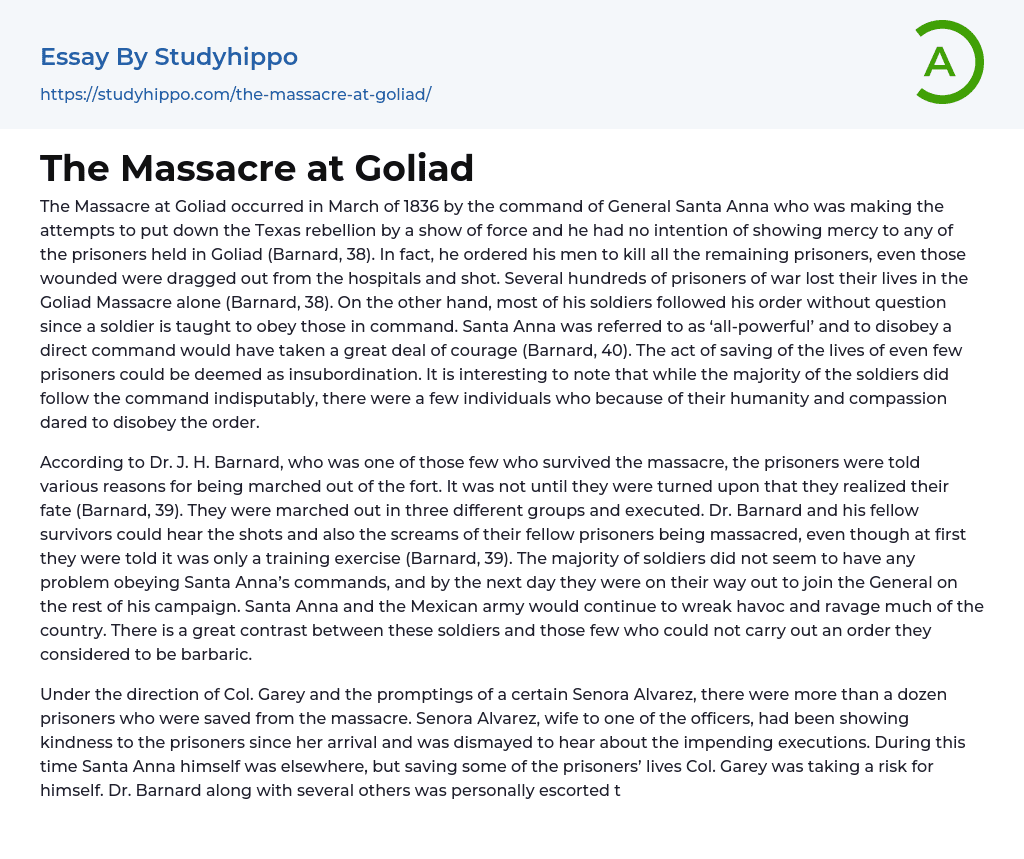The Massacre at Goliad occurred in March of 1836 by the command of General Santa Anna who was making the attempts to put down the Texas rebellion by a show of force and he had no intention of showing mercy to any of the prisoners held in Goliad (Barnard, 38). In fact, he ordered his men to kill all the remaining prisoners, even those wounded were dragged out from the hospitals and shot. Several hundreds of prisoners of war lost their lives in the Goliad Massacre alone (Barnard, 38). On the other hand, most of his soldiers followed his order without question since a soldier is taught to obey those in command. Santa Anna was referred to as ‘all-powerful’ and to disobey a direct command would have taken a great deal of courage (Barnard, 40). The act of saving of the li
...ves of even few prisoners could be deemed as insubordination. It is interesting to note that while the majority of the soldiers did follow the command indisputably, there were a few individuals who because of their humanity and compassion dared to disobey the order.
According to Dr. J. H. Barnard, who was one of those few who survived the massacre, the prisoners were told various reasons for being marched out of the fort. It was not until they were turned upon that they realized their fate (Barnard, 39). They were marched out in three different groups and executed. Dr. Barnard and his fellow survivors could hear the shots and also the screams of their fellow prisoners being massacred, even though at first they were told it was only a training exercise (Barnard, 39)
The majority of soldiers did not seem to have any problem obeying Santa Anna’s commands, and by the next day they were on their way out to join the General on the rest of his campaign. Santa Anna and the Mexican army would continue to wreak havoc and ravage much of the country. There is a great contrast between these soldiers and those few who could not carry out an order they considered to be barbaric.
Under the direction of Col. Garey and the promptings of a certain Senora Alvarez, there were more than a dozen prisoners who were saved from the massacre. Senora Alvarez, wife to one of the officers, had been showing kindness to the prisoners since her arrival and was dismayed to hear about the impending executions. During this time Santa Anna himself was elsewhere, but saving some of the prisoners’ lives Col. Garey was taking a risk for himself. Dr. Barnard along with several others was personally escorted to Col. Garey’s quarters while the executions were taking place. Col. Garey even hid and saved two carpenters that had done some work for him. Senora Alvarez herself was also able to subtly conceal and save several officers. According to Barnard, she had a large part to play in convincing Col. Garey to spare as many prisoners as possible, “she pleaded with Col. Garey, whose humane feelings revolted at the barbarous order that, with great personal responsibility to himself and at great hazard at thus going counter to the orders of the then all-powerful Santa Anna he resolved to save all that he could’ (Barnard, 40). Senora Alvarez and Col. Garey’s actions were
really unprecedented for two nations at war with each other, but the idea of massacring these prisoners of war was appalling to them. The level of safety and kindness they provided for those prisoners was a welcome respite from the usual tales of war. Even though they were helping enemy prisoners, Col. Garey and Senora Alvarez could not deny their sense of humanity. Senora Alvarez, in particular, became well known for her kind actions, while Santa Anna and his army could only be viewed as cruel and pitiless. Santa Anna and the Mexican army surely could not have benefited from this image of cruelty that they now possessed.
When comparing the actions of Col. Garey and Senora Alvarez with the actions of the rest of the soldiers, it is easy to see the difference in characters and compassion. Certainly war tends to have its own rules, but still it is eye-opening to see various reactions among the same group of people. The kindness was not expected. Senora Alvarez could have seen the Texans as rebels and heretics, but instead she offered care to the remaining prisoners (Barnard, 40).
- Air Force essays
- Army essays
- Soldiers essays
- Army Values essays
- United States Army essays
- Veteran essays
- Aircraft essays
- Sergeant essays
- World War I essays
- World War Ii essays
- Atomic Bomb essays
- American Civil War essays
- Attack essays
- Cold War essays
- Crimean War essays
- Emilio Aguinaldo essays
- Iraq War essays
- Korean War essays
- Nazism essays
- Nuclear Weapon essays
- Philippine Revolution essays
- Trench Warfare essays
- Vietnam War essays
- Western Front essays
- Diplomacy essays
- Emperor essays
- Rwanda essays
- Tribe essays
- Revolutionary War essays
- War of 1812 essays
- Mexican American War essays
- Hitler essays
- The Spanish American War essays
- League Of Nations essays
- Battle Of The Somme essays
- Treaty Of Versailles essays
- Fascism essays
- D-day essays
- Atomic Physics essays
- Atomic Bombings Of Hiroshima And Nagasaki essays
- Electron essays
- John Locke essays
- 9/11 essays
- A Good Teacher essays
- A Healthy Diet essays
- A Modest Proposal essays
- A&P essays
- Academic Achievement essays
- Achievement essays
- Achieving goals essays




